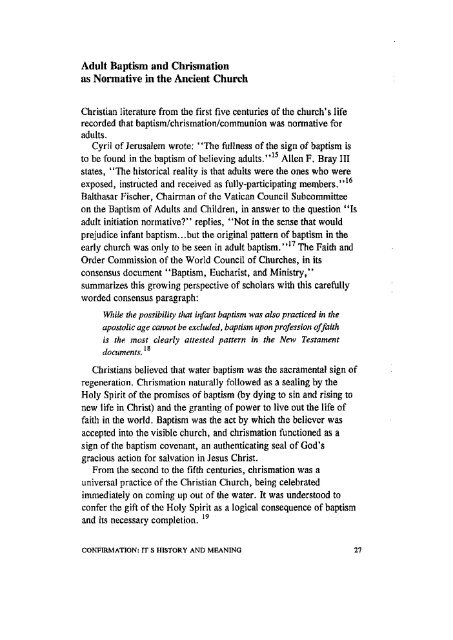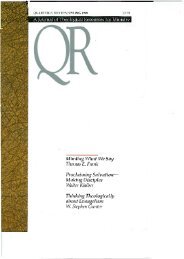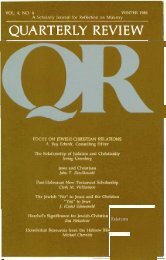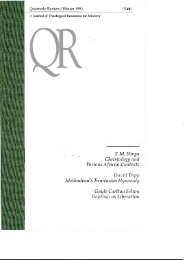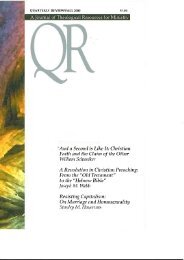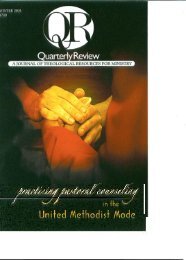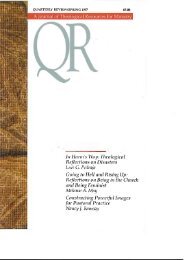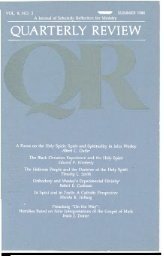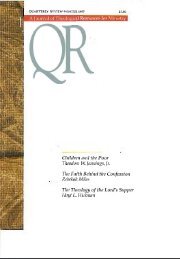TJieodore W. Jennings, Jr. The Meaning of ... - Quarterly Review
TJieodore W. Jennings, Jr. The Meaning of ... - Quarterly Review
TJieodore W. Jennings, Jr. The Meaning of ... - Quarterly Review
Create successful ePaper yourself
Turn your PDF publications into a flip-book with our unique Google optimized e-Paper software.
Adult Baptism and Chrismation<br />
as Normative in the Ancient Church<br />
Christian literature from the first five centuries <strong>of</strong> the church's life<br />
recorded that baptism/chrismation/communion was normative for<br />
adults.<br />
Cyril <strong>of</strong> Jerusalem wrote: "<strong>The</strong> fullness <strong>of</strong> the sign <strong>of</strong> baptism is<br />
to be found in the baptism <strong>of</strong> believing adults." 15<br />
Allen F. Bray III<br />
states, "<strong>The</strong> historical reality is that adults were the ones who were<br />
exposed, instructed and received as fully-participating members." 16<br />
Balthasar Fischer, Chairman <strong>of</strong> the Vatican Council Subcommittee<br />
on the Baptism <strong>of</strong> Adults and Children, in answer to the question "Is<br />
adult initiation normative?" replies, "Not in the sense that would<br />
prejudice infant baptism...but the original pattern <strong>of</strong> baptism in the<br />
early church was only to be seen in adult baptism." 17<br />
<strong>The</strong> Faith and<br />
Order Commission <strong>of</strong> the World Council <strong>of</strong> Churches, in its<br />
consensus document "Baptism, Eucharist, and Ministry,"<br />
summarizes this growing perspective <strong>of</strong> scholars with this carefully<br />
worded consensus paragraph:<br />
While the possibility that infant baptism was also practiced in the<br />
apostolic age cannot be excluded, baptism upon pr<strong>of</strong>ession <strong>of</strong> faith<br />
is the most clearly attested pattern in the New Testament<br />
documents.<br />
Christians believed that water baptism was the sacramental sign <strong>of</strong><br />
regeneration. Chrismation naturally followed as a sealing by the<br />
Holy Spirit <strong>of</strong> the promises <strong>of</strong> baptism (by dying to sin and rising to<br />
new life in Christ) and the granting <strong>of</strong> power to live out the life <strong>of</strong><br />
faith in the world. Baptism was the act by which the believer was<br />
accepted into the visible church, and chrismation functioned as a<br />
sign <strong>of</strong> the baptism covenant, an authenticating seal <strong>of</strong> God's<br />
gracious action for salvation in Jesus Christ.<br />
From the second to the fifth centuries, chrismation was a<br />
universal practice <strong>of</strong> the Christian Church, being celebrated<br />
immediately on coming up out <strong>of</strong> the water. It was understood to<br />
confer the gift <strong>of</strong> the Holy Spirit as a logical consequence <strong>of</strong> baptism<br />
and its necessary completion. 19<br />
CONFIRMATION: IT S HISTORY AND MEANING 27


